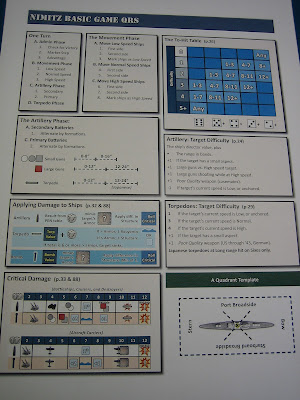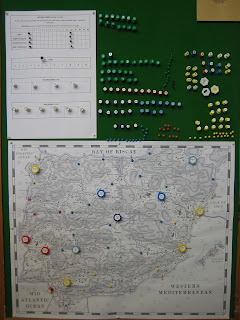As I only have three Spanish units left in the lead pile (I've finished another three Spanish units since the last Napoleonic Project update, more on those later), it's probably time to get some proper use out of what is now, at well over 2,600 men, officially my largest collection. What better way than to launch into a wargame campaign.
Over the last couple of months I've been slowly getting everything for a campaign together, and I'm almost ready to go. We are scheduled to play a naval game with Peter J.'s ships on Wednesday, then hopefully we can start the campaign the week after that.
The players in this umpire-less campaign will be Peter J, Graham H, and Mark D and myself. There will be one Anglo-Portuguese, one Spanish and two French players. Peter J. wants to be Spanish, and that's fine by me. Mark and Graham can dice off for next choices and I will take what's left.
The campaign will be fought over this point to point map. It was downloaded from
here. At full size the map was too big for my map board - I printed the one pictured at 75%. I think these maps are quite brilliant for large area horse and musket campaigns in Europe and I'm very grateful to their cartographer for making them freely available on line.
I decided to start the campaign using armies from around mid 1811. Mostly, this was to give the Anglo-Portuguese player full control of Portugal - it wouldn't be much of a campaign if Wellington got pushed back into the sea on campaign turn 1. As a start date it also makes my Spanish army look about right.
There is one massive fudge - much of the French Army of the North (about 70,000 men) is AWOL. However, this army was employed in trying to hold down the large swathes of Spanish territory under French occupation and took little part in offensive operations - what men were available for 'use in the field' are accounted for in the other armies starting line ups or as campaign card additions. The army's absence helps to even the campaign's odds, which numbers wise are already with the French. I feel that the inclusion of this army as 'a player army' would make it a French walkover unless some very complicated (and boring) rules for policing and garrisons were formulated. It is a leap for the imagination to make but, I simply can't think of ways to effectively keep the Army of the North occupied doing what it did historically - which in wargame terms is virtually nothing! - and make the campaign playable as an enjoyable reasonably balanced game. The two much smaller Spanish armies kicking about northern Spain (total about 25,000 men), which kept popping up to disturb the peace before disappearing into the hills, and which heroically kept the much larger French army dispersed, tied down in garrisons and fruitlessly 'chasing ghosts' about the place, are also AWOL - one lot cancelled the other, so to speak.
To begin with, each army is represented by a single pin placed at its 'campaign jump off' point. The campaign will start with a set up turn. This set up turn will be used to sort out the actual dispositions of the forces before the campaign begins in earnest. This special turn will serve to give the players a run through of a full campaign turn (I will remove the End Turn card); the only caveats for how this special turn is played through is that no one will be allowed to initiate a battle or begin a siege - it is purely a game turn of manoeuvre and positioning.
Note all of the campaign counters (pins) that are stuck into the map board. There are pins for every division (the smallest individually tracked campaign force in the campaign), supply dumps, extreme weather, Guerrilla action and various other things that might feature due to campaign cards and events - I don't think I've forgotten anything.
Here is a sample army roster sheet, in this case for two of the Spanish armies. These note any special divisional units and will be used to track army strength. They are loosely based on historical divisional composition for 1811.
If you look closely you can see starting strength - bold and non-italics number - of each infantry division: Tracking individual units is too much paperwork - I'm happy to simply track divisional strength in unit integrity points (UI) and let players organise their divisions into units when a battle occurs.
I'm not going to track cavalry or artillery at all: Cavalry numbers are a product of infantry numbers, as is artillery. In this case, both Freire and Blake will get 1 UI of cavalry (random unit type) per 6 UI of infantry fielded, and each division will get a battery if it has 9 UI or more.
One thing I have added to the campaign mix is 'hospitals': These are useful for dividing post battle infantry UI losses into two types - temporary and permanent.
One sheet not pictured is the random unit quality table for each troop type. Before battle, a dice will be rolled to determine the quality of each unit.
The game will be card driven. There is a campaign activation deck. This has two activation cards for each army (one for Joseph, alternately controlled by the French players), two 'draw campaign hand cards' for each player (see below) a reinforcement card for each 'nation', two extreme weather cards, a naval move card, and to sow the element of doubt into 'turn sequencing' an
End Turn card. There are 36 cards in total.
Lastly, there is a campaign hand deck of 54 cards, most of which are too detailed to list. They will be picked up by players during campaign activations and can be used by the players at any time during the campaign to help them or their ally, or to hinder the enemy. Hopefully they will add governed campaign flavour and surprises - which is useful in an umpire-less campaign.
Lastly there are four or five pages of rules. I will not detail these until after they have been play tested a bit but, they cover movement, stacking limits, supply & attrition, initiating battle, force concentration from adjacent areas prior to battle, post battle casualty and movement, sieges and the like. I've tried to keep everything pretty simple because past experience has taught me that's usually best.
Once the campaign is properly underway, and any glaring rule errors and omissions have been sorted, I'll make everything available on request.
























